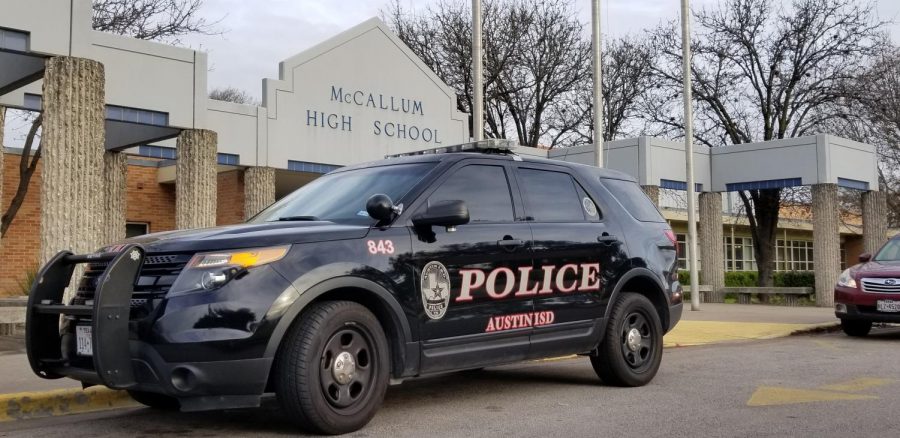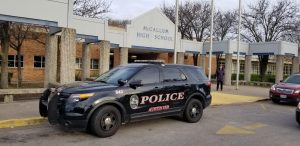Reported threats stoke fear, absenteeism
Student fears prompt principal, teacher to take action to address concerns over campus safety
An AISD police car was parked outside of the front entrance of McCallum on Feb. 14 after terroristic threats from the previous days. AISD police sent extra officers to campus on Valentine’s Day “out of an abundance of caution,” Garrison said.
February 24, 2019
Fear took the place of love on Valentine’s Day at McCallum.
Two days earlier, on the night of Feb. 12, the Austin Police Department was informed of a terroristic threat made by a McCallum student directed towards the McCallum campus. When APD got to the student’s house, he was gone. The police were eventually able to find the student the next morning after the he returned to his home.
“That student had made a comment that he was going to shoot up McCallum, and he said he had access to a gun, according to the information I received,” McCallum principal Michael Garrison said. “APD was called, and by the time APD got [to his home] the student was gone, so the big concern was that they couldn’t locate him from that point, which was about 11 p.m. They found him at home at about 7:30 in the morning. They did arrest, transport and charge him with making a terroristic threat.”
School went on as normal for the most part on Feb. 13, the day the student was arrested, except for zero-hour classes that took place before first period. Students who showed up for Angie Seckar-Martinez and Scott Pass’s zero-hour Calculus BC class, which starts at 7:30 a.m., were escorted into the cafeteria, where they stayed until the student had been arrested. The students were later allowed to go to their class at about 7:50 a.m.
That afternoon, Garrison sent McCallum parents and staff an email informing them of the previous night’s threat, but as soon as the first threat seemed resolved, rumors of multiple new threats began showing up on social media.
“There were other threats that were posted, and one of the threats said something along the lines of: a friend of the student who got arrested is going to come to McCallum and shoot up McCallum,” Garrison said. “It wasn’t the friend; it was some other third party that posted that. And then another post said something is going to happen at lunch time. That post has nothing to do with the situation that originated on Wednesday. That was a text that administration had been informed about several days before, and we were investigating it. So this post created new hype about McCallum not being safe.”
That night, Garrison sent another email to parents and staff informing them of the additional threats that had been made to McCallum over social media.
“At this time, there is no danger to our campus, staff or students,” the email said. “Out of an abundance of caution, however, we will have additional AISD police officers on campus tomorrow morning.”
Other than the extra police officers and many absent students, school proceeded normally on Thursday, Feb. 14 despite the rumored threats.
“The canceling of school is always a district decision, and based on the information they had from the investigation, they didn’t feel like there was a need to cancel school,” Garrison said.
Although it was not Garrison’s decision whether or not to cancel school, he backed up the decision made by the district.

“[The AISD Police Department] doesn’t take threats lightly; they investigate them thoroughly,” Garrison said. “We take all the precautions necessary to keep our staff and students here safe at McCallum.”
Garrison believes that the absence of many students from campus on Feb. 14 was in large part caused by the spread of false or irrelevant information on social media.
“There are a lot of times on social media [when] people try to jump on what’s going on and try to add information that is not relevant to a situation or not true altogether,” Garrison said. “The fact that people put stuff out on social media to try to hype up or exacerbate situations created a lot of worry throughout our school.”
Garrison also understands the worries that parents and students had because of the threats.
“I personally understand that parents are going to be concerned, that students are going to be concerned, and they should be,” Garrison said. “I completely understand that parents and students are going to be alarmed and concerned and afraid and anxious. Those are all very natural reactions given the state of things that occur in our nation. I am glad that a lot of our students and parents felt safe enough and trust the district and McCallum enough that they came back to school [on Feb. 14].”
During fourth period Feb. 14, Garrison came on the intercom to talk to the students and faculty at McCallum about the situation.
“Walking around during the day, I felt like students were really looking for some comfort and reassurance from the adults that everything was OK,” Garrison said. “I did drop into a few classes and talked with a few students, and I noticed how they all came and gathered around while one of the other administrators and I were in a class, and they had questions. … I wanted to reassure them and give them as much true information as I could to help them understand that we’re doing everything we can, and AISD Police and Central Office are doing everything they can to make sure that McCallum is safe for staff and students.”
Garrison was not the only adult at McCallum trying to help students with the difficult situation. English teacher Dana Olson put together a PowerPoint with information from the Department of Homeland Security to try to prepare students in case an active shooter ever did come on campus. Olson says that she put the PowerPoint together in part because she feels that McCallum would not be prepared enough in the case of an active shooter, citing the fact that McCallum does all their drills during one period.
“The only training that we get at McCallum are these lockdown drills, which we only do every once in a while during first period, but the chances of something happening during your first period is one in eight,” Olson said.
Olson also feels like the lockdown drills alone are not enough to prepare students and staff for an active shooter situation.
“I felt like I didn’t have any solutions [for certain problems], and I don’t have any training,” Olson said. “So what do I do in an emergency situation, because, honestly, locking the door, that’s not really going to do much, especially in [my] classroom. In most classrooms at McCallum we have a wall of windows, and so even in the lockdown drill, where are we even supposed to go to hide? We’re seen everywhere.”
So Olson decided to go out and try to find some answers to her questions.
“I was like, ‘I’m sure this information’s on Google’,” Olson said. “So, I Googled it: ‘What do you need to know if there’s an active shooter?’. Department of Homeland Security put together a brochure, and so I just copied and pasted the information from the brochure into a PowerPoint. Then, both yesterday and today, I’m asking my students if this is something they’re interested in going over, and if they are, then great.”
Olson says that she feels like her students have appreciated her efforts to help prepare them for an active shooter.
“So far the response has been really positive, and it made me feel better, and that’s why I’m giving this as an option, because now I feel like the students have a plan, and at the very least they have a plan for this class,” Olson said. “It made me feel better, and I think it’s making them feel safer and making them think a little more actively about what would we do if there is an emergency. Where would we go? What should we be doing?”
Olson also believes that lockdowns themselves are not always the best course of action during an active shooter situation.
“A lockdown is actually the second line of defense when there’s an active shooter, not the first,” Olson said. “That’s what we’re trained to do, is to just lockdown. But I’m right next to a door to exit the building, so why wouldn’t we evacuate?”
Olson believes that some of the problem behind why McCallum is unprepared for an active shooter situation is because nobody wants to talk about it.
“I feel that because it’s not fun to talk about, no one talks about what happens when the shooter is in your room,” Olson said. “Cool, you locked the door, but it’s too late. The shooter is in your room. Then what do you do? And no one ever talks about that, and that’s the scariest part. What do you do if you’re in the hallway? Where do you go? A lot of teachers got sued after Parkland because they wouldn’t open the door, and so I kind of wanted to help my students understand this is why I wouldn’t open the door, and that you need to have a plan when you’re out in the hallway, because your plan A should not be, ‘I’ll go back to my class and my teacher will let me in’, because that goes against lockdown procedure, and it’s a safety concern.”
Olson added that despite feeling unprepared in the event an active shooter ever came to McCallum, she still believed McCallum to be safe on Valentine’s Day.
“I did feel safe coming to school, and I do trust the administrators and Officer Reilly who had talked to Ms. Adamson, who had communicated with us,” Olson said. “I do trust them, and if they say it’s safe to come to school, then I knew they wouldn’t put us in danger. But I do just wish there was some sort of system. We just need to have it. I hope this is a reality check that we are not prepared. If something like this happens again, being unprepared is the most dangerous thing.”
Garrison is appreciative of Olson and the rest of McCallum’s staff for still coming to McCallum despite the threats.
“I am very proud of our staff. All of our teachers showed up and did their job despite the fact that they’re going to have same of those same anxieties and concerns that parents and students are going to have. They know first and foremost that it’s their job to teach and take care of the students, so I’m very proud of our staff for showing up and taking care of everybody [on Feb. 14] and every day.”
Garrison joined Austin ISD Police Chief Ashley Gonzales and Associate Superintendent of High Schools Dr. Craig Shapiro for a Facebook Live discussion of the incidents described in this story. To view the episode, please visit facebook.com/AustinISD or click the link below.







Selena Dejesus-Leyva • Mar 12, 2019 at 10:14 am
I liked that they got a quote from a teacher who is willing to speak her mind and not going to sugar coat her mind. Also its good to know what really happened that day.
Selena Dejesus-Leyva • Mar 12, 2019 at 10:08 am
I liked this article because it shows a perspective of a teacher and speaks her mind and not just sugar coated. Also its good to know that other people do care and can express how they feel.
Grace Van Gorder • Mar 1, 2019 at 2:38 pm
Than you so much for reporting on this. I remember how terrified I was all day at school and I remember how much my mom cried at the thought of letting me go and its comforting to finally know what happened.
Jacob Kuhlenbeck • Mar 1, 2019 at 2:37 pm
This article uses a good blend of quotes and the video really compliments it. I think it shows, very well, what happened those days.
Frances Arellano • Mar 1, 2019 at 11:35 am
I think this is was scary moment for McCallum and its a real threat in our society. I’m so glad that nothing happened.
Lukas Bednar • Feb 26, 2019 at 10:29 am
I like how the article uses pictures and a video to show more about the article. I also like that there are a lot of quotes.
Ivy Golyzniak • Feb 25, 2019 at 4:21 pm
This story makes it very clear and easy to understand what happened those days. It was scary and confusing.
Ashly N Mendez • Feb 25, 2019 at 3:47 pm
the police officers and the teachers did a good work trying to protect us ,trying to make us feeling safe ,they do their best.
Lily Dashner • Feb 25, 2019 at 2:37 pm
This story gives me a little better understanding on what happened to our school. My parents did make me come to school on this day and I actually liked it. I did think this story should tell the readers how many students where at school that day, to give the readers an opinion on how much of the school was here. I know a lot of my friends said they where scared and there parents made them come. I don’t know if that’s actually the reason they didn’t want to come to school or they just didn’t want to come. I do really like that this story tells me facts on what happened on Feb. 14th but maybe it could tell me more on how many student did and didn’t attend. but overall good job.
Henry Sandlin • Feb 25, 2019 at 1:48 pm
I like this story because it clarified what really happened on a subject that probably scared many people.